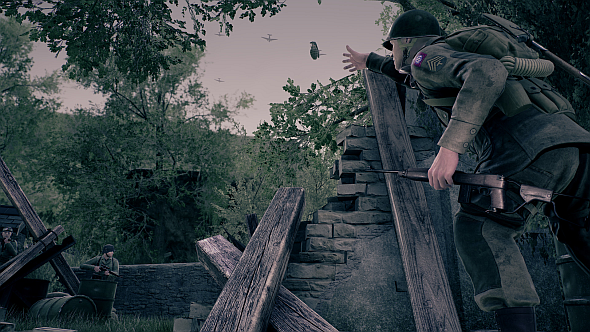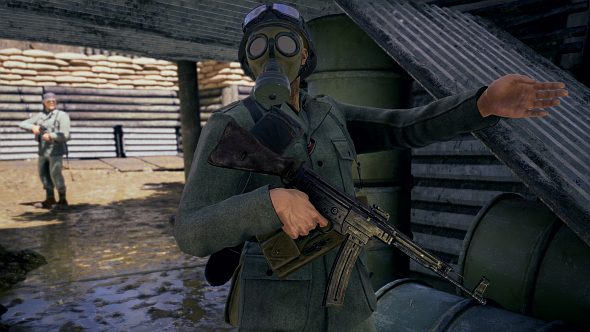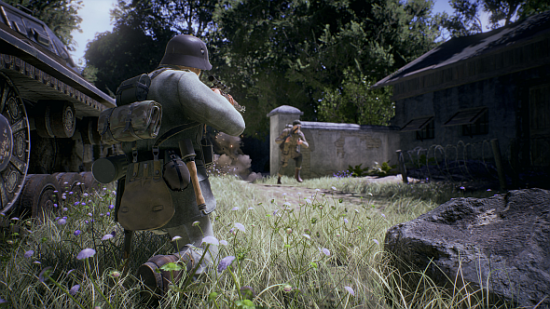Battalion 1944 was announced on Kickstarter early last year, inspired by multiplayer shooters of the period after Quake III: Arena, but before COD 4: Modern Warfare. The pitch clearly struck a chord, as it went on to raise more than triple its £100,000 funding goal. The game was playable for the first time at EGX Rezzed last week, so I took the chance to ventilate a few Nazis and chat to developer Bulkhead Interactive.
I’m put on the American team in a 4v4 deathmatch against other Rezzed attendees. After a few seconds I’m reminded of Call of Duty; times-to-kill are maybe a touch longer, but certainly nothing approaching those of arcade shooters such as Quake. Thanks to the small map, fast reloads and rapid respawns, Battalion shares COD’s pacing. Exciting, sure, but I worry this is going to be something I’ve seen before.
By the end of my too-short ten minutes with the game, I’m not worried any more. It’s clear there’s more going on here. It feels different – it feels good.
Once more, with feeling

The devs quickly explain why. “We’ve been doing research,” says producer and designer Joe Brammer. “And actual research, not just playing an old-school game and going ‘this feels good’, but breaking it down, tweaking things.”
Creative producer and designer Howard Philpott says they’ve pored over footage of their influences to work out why they feel the way they do – frame-by-frame, in some cases. Those influences run the gamut of ‘90s and early ‘00s shooters, including Quake, Unreal Tournament, Wolfenstein: Enemy Territory, Counter-Strike, Battlefield 2 (not Bad Company 2, as Brammer is keen to emphasise) and early Call of Duty, particularly COD 2.
Contrasting the polished and feature-laden direction that shooters have taken since those days, Bulkhead says the rough edges that have been lost were what gave classic games their personality.
“Crouch-jump is how you used to get up on boxes that were just slightly too high,” says Brammer. “Now it’s go up to it, press A, climb onto it. And I think that took you out of it a bit. It didn’t give you the control – the game controlled you.”
Battalion makes minimal use of such animations; there are no context-sensitive button prompts leading to camera-locked sequences where you mantle something. Reloads are (relatively) quick, and are pretty much the only time you can’t shoot stuff. Even picking up enemy weapons is instantaneous – a noticeable rough edge that you might call ‘immersion-breaking’, but if you did, Brammer would want a word.
“I hate the word ‘immersion’ in games because gamers think immersion means you believe you’re a soldier. And that’s never gonna fucking happen. You don’t,” he says. “Immersion just means you’re focused and in the moment, living in the zone… it’s tunnel-vision into the game, not into a different world.”
Lotus versus Lamborghini

So it’s clear that a great deal of thought has gone into the stuff that isn’t here. “Simplify, then add lightness” was purportedly the mantra of Lotus engineer Colin Chapman, and though designing cars and games don’t have a lot in common on a superficial level, the comparison works here. Battalion feels as it does because it’s COD with added lightness. COD before it got fat.
I wouldn’t say there’s much skill in the gunplay, and Brammer admits that they’re not trying to be a Counter-Strike, in which the overwhelming headshot bias and round economy create a cautious game that’s all about aiming and controlling angles. Rather, Battalion’s skill, like classic COD’s, will be in its movement.
Brammer mentions “little things like strafe-jumping and fast reloading, that create a little bit of a skill gap,” and I remember a duel during my hands-on time in which a bit of bunny-hopping kept me alive while I finished a reload. (Incidentally, I topped the scoreboard with 32 kills to 8 deaths – something I thought I’d be above bragging about, but here we are.) This is impossible in most modern shooters because they usually punish your aim or mobility when you jump, but in Battalion it’s a viable tactic again.
Battalion 1944 will launch with a bomb/defuse mode called Search and Destroy, which Philpott says will be “the main focus of the game.” Hence, when it comes to level design, Bulkhead have “been looking at Counter-Strike and the way they do things, but also looking back at COD 2 with its verticality, and trying to incorporate that into the level design of CS:GO.” Expect figure-of-eight maps, with routes around their perimeters too, all thoroughly playtested to ensure that “the flow works in both Team Deathmatch and Search and Destroy.”
Brammer expands on the verticality point, wistfully citing games like Quake in which there were as many as six floors in a level. In Battalion, besides the ground floor and first floor, “there’s this middle layer of running on walls and jumping on roofs and balconies”. So practice your crouch-jumps and learn the maps, and new paths and angles of attack will open up to you.
Back to reality

I have to ask about the aesthetics. The 20th century is back in shooters in a big way, with the success of Battlefield 1, COD’s impending return to World War II, and other contenders such as Days of War, Enlisted, Raid: World War II and Day of Infamy. Lots of competition, or so you’d think – but according to Bulkhead, the aesthetics of Battalion 1944 don’t really matter.
“It’s not a World War Two game,” says Brammer. “It’s an old-school, classic first-person shooter. World War Two is just a palette.” Philpott agrees: “We could take Battalion into any setting we wanted to.”
Because of this, they don’t see the sudden rush of WWII games as competitors. Philpott says “we actually put COD next to Battalion, and we listed the advantages of both franchises, and we basically came out on top on certain things and we’ve tried to nail them.”
We’re back to the way Battalion feels, achieved through focused attention to the details that made classic shooters great, and a movement-based skill gap. These are the things that Bulkhead say are now unique to their game. When it comes to COD, Bulkhead see themselves as being the PES to COD’s FIFA. “I love FIFA,” says Brammer. “Great game, and I love PES as well, but PES fans consider theirs the more skill-based game, and that’s the way we want our fans to see us.”
A legacy of lead: check out the best shooters on PC
If Battalion has a rival at all, Brammer says it might be Strafe, the fast-paced, procedurally-generated FPS with the ludicrous marketing that’s also seeking to recapture the feel of ‘90s shooters, but with a sci-fi aesthetic. That Bulkhead see Strafe as their competition tells you a lot about how they think of Battalion.
Battalion 1944 has an early access page, but it’s not playable just yet. Bulkhead are guessing that’ll happen around August, with an alpha in May.
I’m excited, for sure. After only ten minutes I don’t know what it’ll be like to live with in the long-term, but I know its core gameplay feels pretty damn good in the short.
